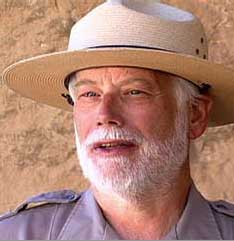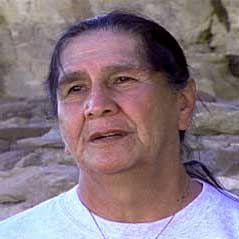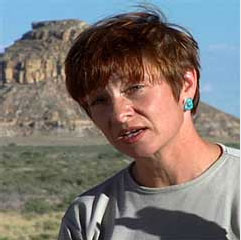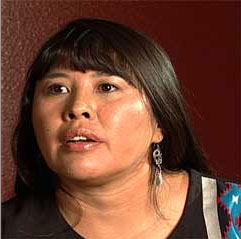Biographies
 G.
B. CORNUCOPIA
G.
B. CORNUCOPIA
Interpreter at Chaco Canyon National Park
"I
came to the Southwest for a variety of reasons, one of which was
astronomy," says G. B. Cornucopia, who has been fondly dubbed
"Mr. Chaco." He has been an interpreter and park ranger
at Chaco Canyon for eighteen years. "I heard about Chaco Canyon
from Carl Sagan's TV series, Cosmos. Several segments were filmed
here, especially regarding the study of archeoastronomy; and then
I found out about all these studies that had been done since 1970
that tried to illuminate the people, their astronomical practices
and traditions. I just found that fascinating . . . that brought
me here at first, and it's still one of the important things that
holds me here. . . ."
Mr. Cornucopia organized the donation of telescopes to the Chaco
Observatory and began the first public astronomy program at a national
park. But his interest in Chaco goes beyond astronomy.
Three years ago, he arranged for a local Puebloan dance group to
come and perform traditional dances at Pueblo Bonito for the first
time in hundreds of years. He wanted to both connect these people
to their past and continue the ancient traditions that are at the
core of the Chacoan culture.
 ANDREW
GARCIA Sr.
ANDREW
GARCIA Sr.
Coordinator
Tewa Dancers from the North
San Juan Pueblo
"I
felt something here, a chill . . . this is where my people were,
my grandfathers. And to be here is an honor. To sing, and to have
my dancers do the dances that they taught us. They were the ones
who created all of these things that we do today. That's why I feel
real proud that I can be able to come to this place, because this
place is where it all started. Today, I'm one of the children of
this place. And to see all the footsteps of people that came here
to visit this place, and then to also have mine here, is really
an honor."
Andrew Garcia Sr. is a member of the Pueblo of San Juan Tribe, a
university professor, and a Vietnam veteran. His fundamental motivation
is to find a viable and sustainable way of preserving his culture's
artistic heritage. In 1976, he founded The Tewa Dancers from the
North, a Native American dance group that has taken the indigenous
southwestern aesthetic around the world. He is dedicated not only
to preserving the ancient dances of the Puebloans but also to reestablishing
the deeper cultural connections that the dances embody.
 ISABEL
HAWKINS, Ph.D.
ISABEL
HAWKINS, Ph.D.
Solar Reasearcher, University of California, Berkeley
"There's
so much sun-earth connection all around us here . . . the people
that lived here about a thousand years ago were so keenly interested
in understanding their place in the universe. . . ."
As a research astronomer and senior fellow in science education,
Isabel Hawkins conducts research in astronomy and space science
education, and is the director of the Center for Science Education
at the University of California, Berkeley, Space Sciences Laboratory
(SSL). SSL is an organized research unit that builds and operates
NASA space science satellite missions. Dr. Hawkins's primary area
of astrophysics expertise is in chemical abundances of the interstellar
medium. As director of SSL's Center for Science Education, she is
principal investigator of several national education initiatives,
including the NASA Office of Space Science's Sun-Earth Connection
Education Forum (in collaboration with Goddard Space Flight Center),
and Project FIRST (Fostering Reading Through Science and Technology).
Dr. Hawkins received her B.S. in physics from the University of
California, Riverside, and her Ph.D. in astronomy from the University
of California, Los Angeles. She is a member of the NASA Office of
Space Science Education Council and a former member of NASA's Space
Science Advisory Committee.
 SHELLY VALDEZ, Ph.D.
SHELLY VALDEZ, Ph.D.
Educator
Laguna Pueblo
"I'm
from Laguna Pueblo, and personally, for me, Chaco is a story within
itself. It's a connection with my people, and it's one of our ancestral
homes."
Dr. Shelly Valdez has worked in education for over twenty years
in a variety of positions, including classroom teacher, project
director for the Four Directions Technology Project - An Indigenous
Model, and associate director for K-12 programs at the American
Indian Science and Engineering Society (AISES). She has both a B.A.
and an M.A. in elementary education and a Ph.D. in multicultural
teacher education, with a concentration on research in the area
of science education. She currently is the owner and manager of
an educational consulting business, Native Pathways (NaPs), located
in New Mexico.
Dr. Valdez believes that culturally responsive education works,
and she plans to continue in the path of her father: empowering
Native American youth to achieve a balance between pursuing their
dreams and maintaining contact with their traditional world.

 G.
B. CORNUCOPIA
G.
B. CORNUCOPIA
 ANDREW
GARCIA Sr.
ANDREW
GARCIA Sr.
 ISABEL
HAWKINS, Ph.D.
ISABEL
HAWKINS, Ph.D.
